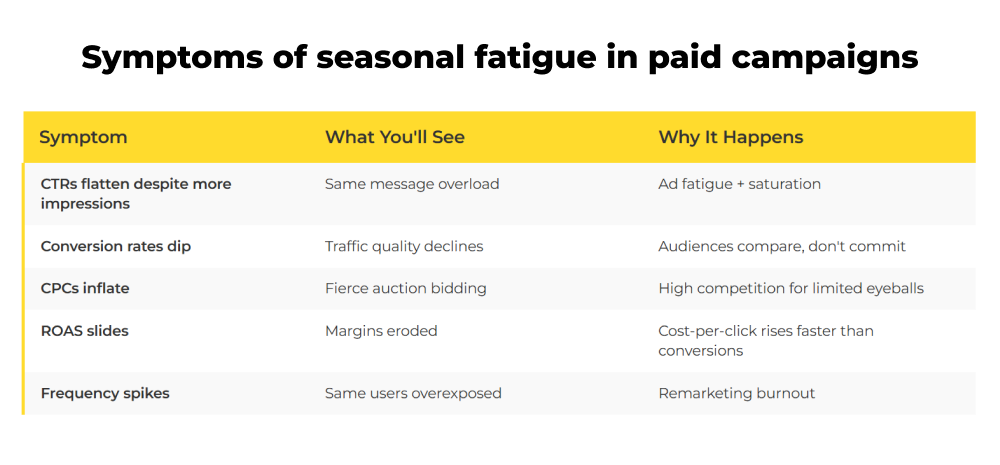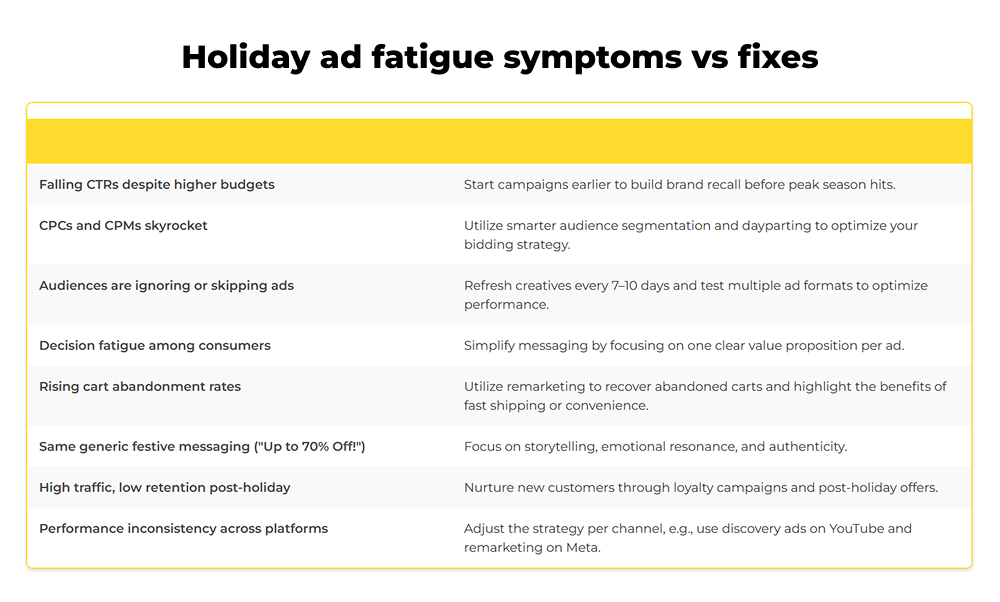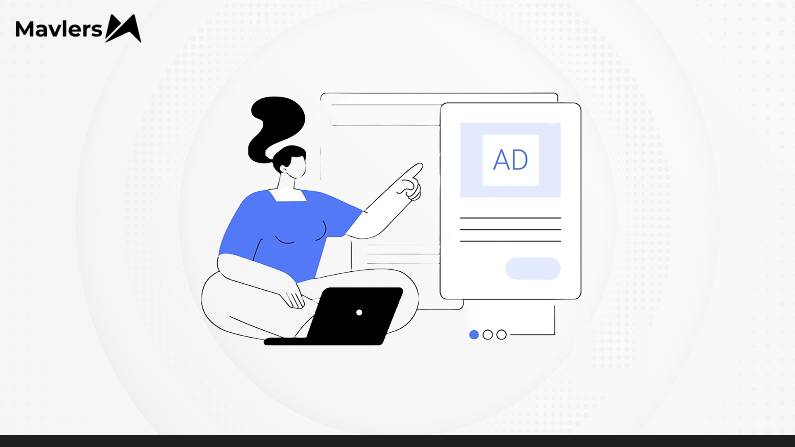Every year, as November and December roll around, paid media managers across the world gear up for what we lovingly call “the golden quarter.”
Black Friday. Cyber Monday. Christmas. Boxing Day.

The calendar’s loaded with high-intent shopping opportunities, and optimism is in the air. Budgets expand, bids intensify, creatives sparkle, and yet, behind closed dashboards, many advertisers quietly admit a frustrating truth:
“Our holiday campaigns didn’t perform as well as we expected.”
Despite all the hype, bigger spends, and flashier creatives, holiday ads don’t always deliver the best ROI.
This often-overlooked dip, known as seasonal fatigue, is a silent killer of holiday ad performance.
It’s what happens when audiences are showered with too many festive ads: they tend to tune out the noise and scroll right past your hard work.
With over 13 years of experience and expertise in the SEM sphere, we at Mavlers will help you understand why this happens, what it looks like in your metrics, and how you can avoid the fatigue trap this holiday season.
But what is seasonal fatigue?!
Seasonal fatigue occurs when ad performance declines during peak shopping periods, not because people aren’t buying, but because they’re overstimulated.
Everyone’s shouting “SALE!” in all caps. Every brand is “your one-stop Christmas destination.” Every scroll, every story, every YouTube preroll looks and sounds the same.
The result may look like;
~ A dip in engagement rates.
~ CPCs climb.
~ Conversion efficiency stalls.
Even though audiences are ready to shop, they’re also hyper-selective. They’ll engage only with the brands that manage to stand out, not the ones that blend into the festive noise.
And that’s the paradox of Q4: demand is sky-high, but attention is at its lowest.
Why holiday ads don’t always perform best
Here’s where the fun (and pain) begins. Let’s unpack the key reasons your meticulously crafted holiday campaigns might not hit those record-breaking numbers.
1. Ad saturation: Everyone is saying the same thing
By mid-November, search results and social feeds look like a copy-paste convention:
“Best Christmas Deals!”
“Black Friday Mega Sale!”
“Up to 70% Off!”
You know the drill!
When every brand screams the same message, consumers stop listening. It’s a psychological phenomenon known as banner blindness; the more something resembles an ad, the faster the brain tends to tune it out.
Even if your offer is genuinely compelling, it visually registers as “just another sale.”
In other words, you’re not losing because your offer is weak; you’re losing because your context is cluttered.
2. Rising costs, shrinking margins
Q4 is an auctioneer’s dream and a media buyer’s nightmare.
Competition peaks. CPCs skyrocket. CPMs double, sometimes triple. Smaller advertisers often get priced out of prime placements altogether.
Even if your sales volume increases, your cost per acquisition (CPA) may rise so much that your profit margins shrink quietly. You might technically win conversions but lose on efficiency, a classic “vanity success.”
And the platforms, well, they’re happy to keep you bidding.
3. Decision fatigue: Too many choices kill action
Consumers are drowning in choice. Every scroll offers another “limited-time” deal, another countdown clock, another urgent “ends tonight!” banner.
Instead of inspiring purchases, this constant pressure often causes decision paralysis.
Buyers think, “I’ll wait a day, maybe a better deal will pop up.”
The result may be abandoned carts, delayed checkouts, and missed revenue. Ironically, too much urgency can slow down conversion.
4. Short-term hype vs. long-term loyalty
Holiday ads tend to chase short-term sales spikes. Deep discounts attract buyers, but often the wrong kind of buyers.
When you train customers to wait for your next big sale, you attract bargain hunters rather than brand loyalists.
The danger? Well, your January performance craters, and customer lifetime value (CLV) erodes.
Seasonal performance isn’t just about what happens in-season; it’s about what carries over when the fairy lights come down.
5. Trust and authenticity take a hit
Let’s be honest, consumers have seen “50% Off Everything” so many times that it barely registers as a genuine offer anymore.
During the festive rush, skepticism skyrockets. If your messaging feels generic or exaggerated, you risk coming off as inauthentic.
Audiences crave honest storytelling, not recycled hyperbole. They respond better to real customer reviews, behind-the-scenes moments, or brand values that resonate beyond the sale sticker.
Digging up the data behind the dip!
Here’s how seasonal fatigue typically manifests in your analytics dashboard:

If you do recognize this pattern, it’s probably your campaign waving the white flag of fatigue.
How to beat seasonal fatigue (Without losing your mind or your margin)
Now for the good news, holiday ad fatigue ain’t inevitable!
With the right pacing, creative refreshes, and audience logic, you can ride the seasonal surge without burning out your campaigns or your audience.
Here’s a tried-and-tested survival playbook.
1. Take the lead before the season peaks
Don’t wait for the calendar to scream “Black Friday” before you show up.
It’s recommended to start early and build awareness weeks ahead.
You may warm up your audience using:
~ Demand generation campaigns
~ Content marketing (gift guides, how-tos)
~ Smart remarketing sequences
So, when the buying frenzy hits, you’ll already have mindshare and won’t be competing only on discount depth.
We got a pro tip for you! Google Ads’ newer campaign total budgets feature (rolled out in 2025) can help you plan spending across phases, ensuring your budget doesn’t burn too early.
2. Focus on differentiation, not discounts
While almost everyone offers discounts, only a few differentiate themselves.
If your copy looks like everyone else’s (“Up to 70% Off!”), Your CTRs will tank not because you’re irrelevant, but because you’re indistinguishable.
Instead, you could:
~ Highlight unique product benefits
~ Showcase authentic customer stories
~ Build emotional resonance rather than transactional urgency
For example, instead of saying, “Christmas Sale: 40% Off,” say,
“Make This Christmas Stress-Free, Our All-in-One Gift Bundles Deliver Joy (and Sanity).”
That’s not just copy. That’s positioning.
3. Use micro-moments to stay relevant
Not every holiday searcher is “gift shopping.”
Some want speed, while others want convenience. Some want “gifts under ₹1000” others may dig “eco-friendly packaging.”
Tap into these micro-intents. Think:
“Delivered in 48 Hours”
“Last-Minute Gifts That Actually Impress”
“Sustainable Gifts That Feel Thoughtful”
Micro-moment targeting breaks through fatigue because it aligns with real-time needs, not generic seasonality.
4. Refresh creatives frequently
Holiday attention spans are shorter than a TikTok scroll.
Audiences see hundreds of ads daily, so creative fatigue hits faster than usual.
It’s a good practice to totate your creatives every 7–10 days:
~ Try switching formats (carousel, video, static, interactive)
~ Vary visuals and CTAs
~ Introduce new storytelling hooks each week
Keep your ads alive, literally, because stale creative is the quickest route to digging your way to the campaign grave.
5. Segment and exclude smartly
Your holiday audience isn’t one giant blob; therefore, it’s good to segment smartly:
~ Loyal customers: reward them with VIP-style offers or early access.
~ Cart abandoners: nudge them with urgency and reassurance (e.g., “Still thinking? Order today for guaranteed delivery!”).
~ Cold audiences: introduce your brand, not your discounts.
And don’t forget to exclude negative audiences, unqualified users, or repeat non-converters. Every wasted impression is an opportunity cost during high-CPC seasons.
6. Extend the value beyond the holidays
Think long-term. The holidays shouldn’t be your endgame; they’re your entry point.
Therefore, once the rush subsides:
~ Retarget festive browsers in January (CPMs drop, and intent lingers).
~ Invite new buyers to loyalty programs or referral loops.
~ Use post-holiday email and SMS flows to nurture relationships.
The brands that sustain beyond December are the ones that plan for continuity, not closure.
7. Budget pacing & “fatigue buffers”
Avoid front-loading your entire spend; instead, you could:
~ Use budget pacing rules so campaigns don’t drain too soon.
~ Reserve 10–20% as a flex fund for mid-season optimization.
~ Shift budget dynamically between performing ad sets and creative tests.
Try to think of it as marathon pacing, not a sprint. It keeps fatigue and panic at bay.
8. Be ready to pivot
During the holiday season, data shifts by the hour. Set alerts for CTR drops, CPC spikes, or conversion dips.
If something fatigues, pause, pivot, and replace.
Have backup creatives and alternate CTAs ready, because the fastest responders win the auction war.
Here’s a quick refresher!

The road ahead
Want to level up your campaign attribution game? Then Google Ads attribution models explained: What every PPC marketer needs to know, should be your next read!


Pooja Ghariwala - Subject Matter Expert (SME)
Pooja Ghariwala is an experienced SEM Analyst with over five years of expertise in digital marketing. In her current role, she manages and optimizes campaigns across platforms like Google Ads, Meta Ads, and LinkedIn Ads, ensuring her clients' marketing goals are met. She directly interacts with clients to address their queries and provide strategic guidance.
Naina Sandhir - Content Writer
A content writer at Mavlers, Naina pens quirky, inimitable, and damn relatable content after an in-depth and critical dissection of the topic in question. When not hiking across the Himalayas, she can be found buried in a book with spectacles dangling off her nose!
Why smart brands treat paid media as a product research lab
From An Emerging Platform to Becoming a Go-to Choice - Webflow CMS